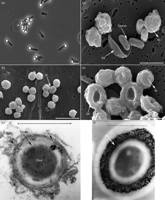Bacillus odysseyi
Classification
Domain/Superkingdom/Kingdom: Bacteria; Phylum: Firmicutes; Class: Bacilli; Order: Bacillales; Family: Bacillaceae
Bacillus odysseyi
Description and Significance
Much is not known about the microbe Bacillus odysseyi because it was recently found on the spacecraft Mars Odysseyi. Characteristically similar to the Firmicutes, Bacillus odysseyi is a gram positive bacterium, with very few guanosine-cytosine bonds. It is rod-shaped, about 4-5 μm in length, and forms round spores at the terminal ends of its cell. B. odysseyi is a motile microbe, but how it moves is still unknown. When cultured in a lab, the colonies of B. odysseyi appear round, smooth and flat with entire edges. The colonies are observed to be beige in color as well. Prolonged incubation stunts the breakdown of sugars to acids. The significance of this microbe is it was among the first microbes isolated from another planet. This indicates that Earth is not the only planet in the solar system that can sustain life. [1]
Structure, Metabolism, and Life Cycle
B. odysseyi is a little different than most Bacillus bacterium because it produces an exosporium, which is hypothesized to be responsible for its adaptation to extreme clean conditions and its direct attachment to the spacecraft. This bacterium grows at a temperature of 25°C-45°C, optimum temperature 30°C-35°C, and at a pH 6-10, optimum pH at 6-7. Sodium ions are not essential for the growth of B. odysseyi, but it does grow in a 0-5% NaCl solution. Bacillus odysseyi is an aerobic microbe meaning it can grow in the presence of oxygen. It prefers pyruvate, amino acids, purine/pyrimidine bases and related compounds as carbon sources. This microbe does not produce hydrogen sulfide, is not involved in dentrification, and it is catalase positive. The spores of Bacillus are extremely resistant, in that they can withstand desiccation, hydrogen peroxide, UV radiation, and gamma radiation. [1]
Ecology and Pathogenesis
Bacillus Odysseyi was isolated from the surface of the Mars Odysseyi spacecraft. It pathogenesis is unknown at this time. [1]
References
[1] La Duc, Myron T., Satomi, Masataka, Venkateswaran, Kasthuri. 2004. "Bacillus odysseyi sp. nov., a round, spore-forming bacillus isolated from the Mars Odysseyi spacecraft". "International Journal of Systematic and Evoluntionary Microbiology". 54: 195-201. http://ijs.sgmjournals.org/content/54/1/195.long
Author
Page authored by Brittney Pankratz, student of Mandy Brosnahan, Instructor at the University of Minnesota-Twin Cities, MICB 3301/3303: Biology of Microorganisms.

